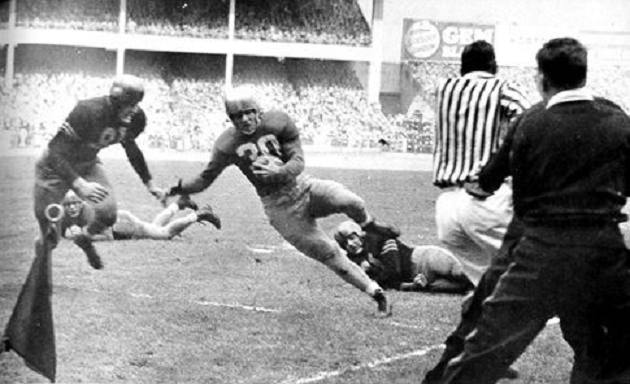


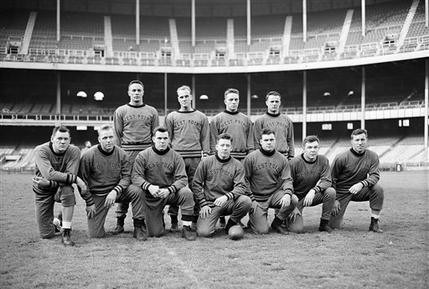
| Villanova (6-4) | 35-0 | |
| Oklahoma (8-3) | 21-7 | #14 |
| Cornell (5-3-1) | 46-21 | #19 |
| at Michigan (6-2-1) | 20-13 | #5 |
| Columbia (6-3) | 48-14 | #17 |
| (NYC) Duke (4-5) | 19-0 | |
| West Virginia (5-5) | 19-0 | |
| (Bronx) Notre Dame (8-0-1) | 0-0 | #1 |
| at Penn (6-2) | 34-7 | #12 |
| (Philadelphia) Navy (1-8) | 21-18 |
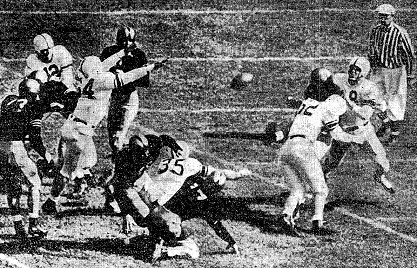
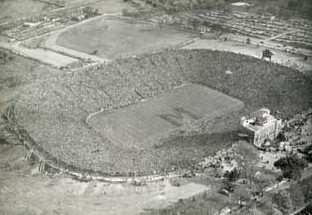
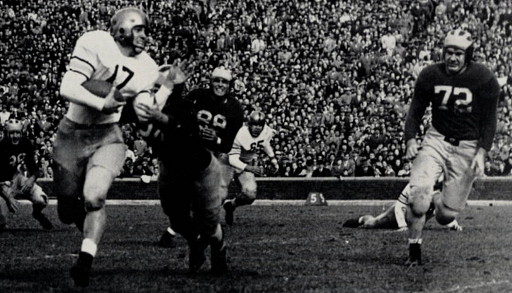
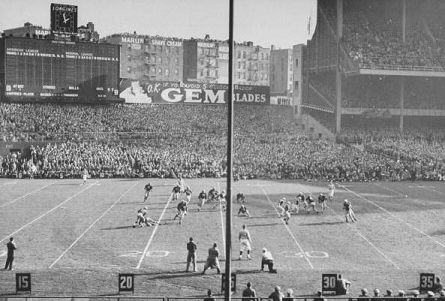
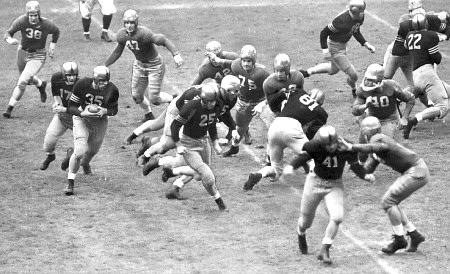
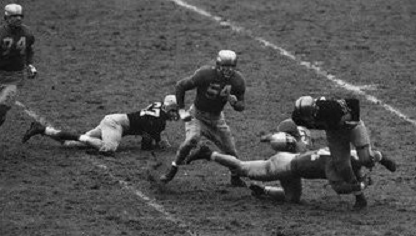
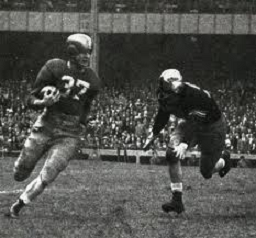
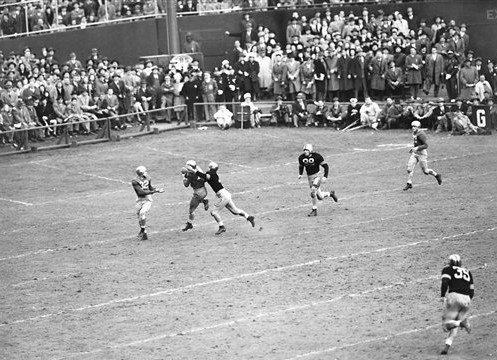
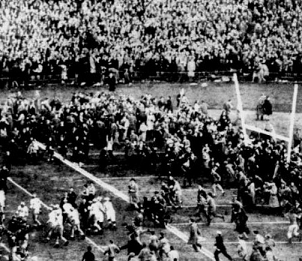
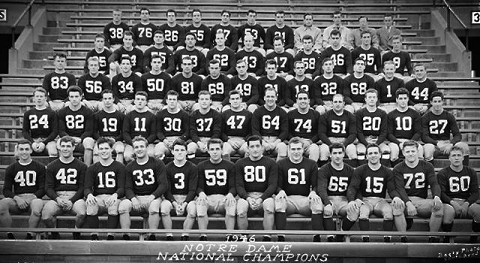
| at Illinois (8-2) | 26-6 | #4 |
| Pittsburgh (3-5-1) | 33-0 | |
| Purdue (2-6-1) | 49-6 | |
| at Iowa (5-4) | 41-6 | |
| at Navy (1-8) | 28-0 | |
| (Bronx) Army (9-0-1) | 0-0 | #2 |
| Northwestern (4-4-1) | 27-0 | |
| at Tulane (3-7) | 41-0 | |
| Southern Cal (6-4) | 26-6 |
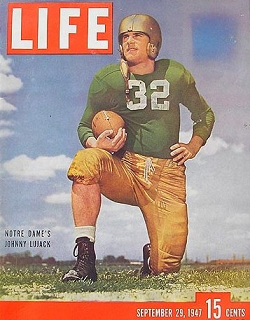 Notre Dame had previously won MNCs in 1924, 1929, 1930, and 1943.
I covered their legendary coach, Frank Leahy, in the linked 1943
national championship article. He had been serving in the military in
1944 and 1945, returning to Notre Dame this season, so as a college
football coach, this season represented a 2nd consecutive MNC. And he
would win another MNC in 1947 for his own college football "threepeat."
Notre Dame had previously won MNCs in 1924, 1929, 1930, and 1943.
I covered their legendary coach, Frank Leahy, in the linked 1943
national championship article. He had been serving in the military in
1944 and 1945, returning to Notre Dame this season, so as a college
football coach, this season represented a 2nd consecutive MNC. And he
would win another MNC in 1947 for his own college football "threepeat."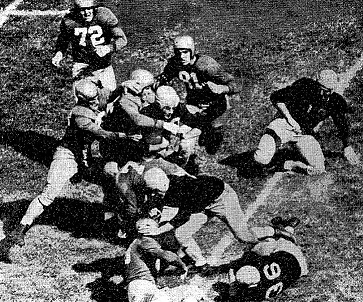
| Clemson (4-5) | 35-12 | |
| at Temple (2-4-2) | 35-7 | |
| Kentucky (7-3) | 28-13 | #22 |
| Oklahoma State (3-7-1) | 33-13 | |
| at Furman (2-8) | 70-7 | |
| Alabama (7-4) | 14-0 | #21 |
| (Jacksonville) Florida (0-9) | 33-14 | |
| (Columbus) Auburn (4-6) | 41-0 | |
| at Tennessee-Chattanooga (5-5) | 48-27 | |
| Georgia Tech (9-2) | 35-7 | #6 |
| Sugar Bowl North Carolina (8-2-1) | 20-10 | #11 |
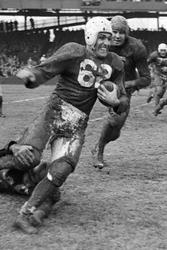 Georgia
was lost in the all-engulfing shadows cast by Notre Dame and Army this
season, but they went 11-0, played 4 top 25 caliber teams, and no one
came within a touchdown of them. They had won their first MNC in 1942, and I covered their Hall of Fame coach, Wally Butts, in that national championship article.
Georgia
was lost in the all-engulfing shadows cast by Notre Dame and Army this
season, but they went 11-0, played 4 top 25 caliber teams, and no one
came within a touchdown of them. They had won their first MNC in 1942, and I covered their Hall of Fame coach, Wally Butts, in that national championship article.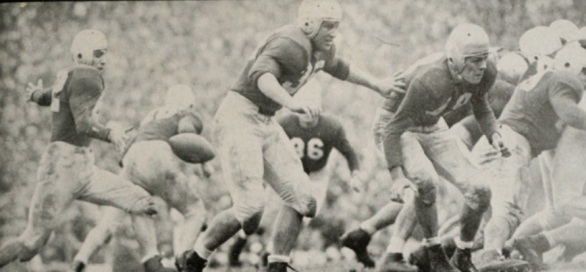
| Army 9-0-1 | Notre Dame 8-0-1 | Georgia 11-0 | ||||||||||||||||||||||||||||||||||||||||||
|---|---|---|---|---|---|---|---|---|---|---|---|---|---|---|---|---|---|---|---|---|---|---|---|---|---|---|---|---|---|---|---|---|---|---|---|---|---|---|---|---|---|---|---|---|
|
|
|
||||||||||||||||||||||||||||||||||||||||||
| 1) Boand
(math system) |
5.0 |
| 2) AP Poll College Football Researchers Association Poling (math) |
4.93 |
| 5) DeVold (math) | 4.90 |
| 6) Billingsley (math) | 4.85 |
| 7) National Championship Foundation | 4.67 |
| 8) Litkenhous (math) | 4.61 |
| 9) Houlgate (math) | 4.40 |
| 10) Dunkel (math) | 4.20 |
| 11) Berryman (math) | 4.17 |
| 12) Sagarin (math) | 4.15 |
| 13) Helms Foundation | 4.13 |
| 14) Sagarin-ELO (math) | 4.03 |
| 15) Williamson (math) | 3.49 |
| 1) Boand (math system) | 4.26 |
| 2) College Football Researchers Association | 4.22 |
| 3) Poling (math) | 4.11 |
| 4) Helms | 4.09 |
| 5) Sagarin-ELO (math) | 4.06 |
| 6) National Championship Foundation | 3.96 |
| 7) Dickinson (math) | 3.49 |
| 8) Houlgate (math) | 3.35 |
| 9) Billingsley (math) | 3.34 |
| 10) Sagarin (math) | 3.28 |
| 11) Parke Davis | 2.77 |
| 1) Houlgate (math system) | 4.5 |
| 2) Helms | 4.3 |
| 3) Parke Davis | 4.2 |
| 4) National Championship Foundation | 3.7 |
| 5) Billingsley (math) | 3.6 |